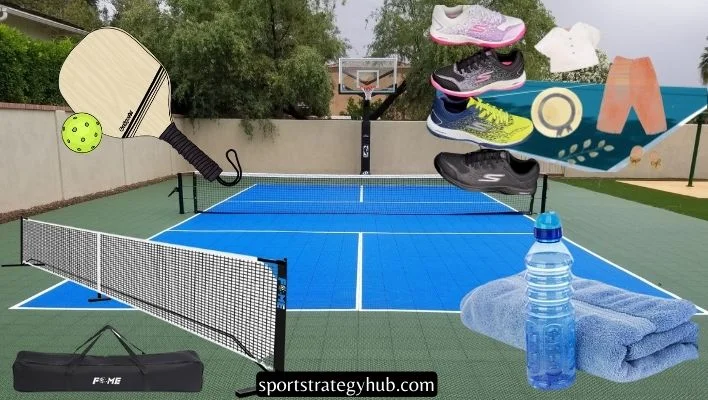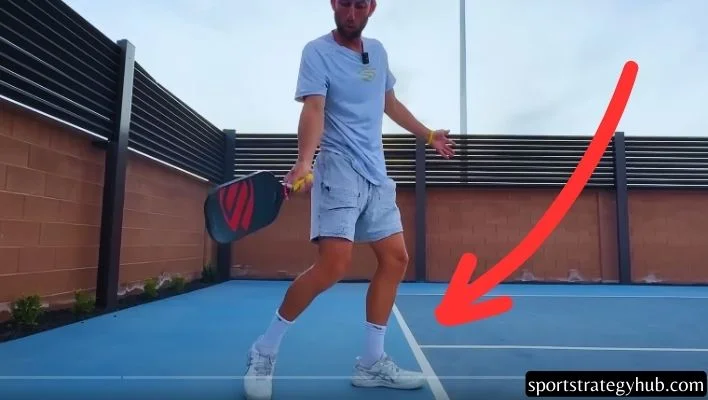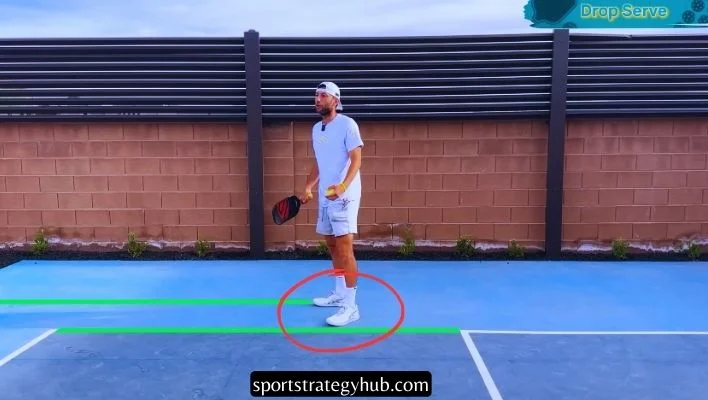How to Play Pickleball: Step by Step | Basic 9 Rules & Strategies
Pickleball, a sport that ingeniously combines elements from tennis, badminton, and ping pong, offers an exhilarating and accessible experience for players of all levels. This guide is carefully designed to help anyone interested in learning pickleball, perfect for beginners or those aiming to improve their skills. We delve into the essential gear you’ll need, the foundational rules that govern the game, effective serving techniques to get you started, and strategic insights to give you an edge over your opponents. Armed with your paddle and dressed in your court shoes, you’re all set to tackle the challenge and excitement of learning how to play pickleball. Join us as we navigate the ins and outs of this captivating sport.
What You Need to Play Pickleball

Before you hit the pickleball court, ensure you’re well-equipped. Here’s what you need to start playing:
- Pickleball Paddle: This is crucial for playing pickleball. Larger than a ping-pong paddle, it should feel right in your grip and match how you play.
- Pickleball Ball: These balls are special, designed with holes, and crafted from tough plastic. Depending on whether you’re playing indoors or outdoors, pick the right type of ball.
- Pickleball Court: Smaller than tennis courts, pickleball courts have particular measurements and zones, including a no-volley zone close to the net. These courts are often found at local parks, community centers, or tennis clubs.
- Net System: To set your court up correctly, you need a net that’s 36 inches tall at the ends and 34 inches in the middle. Ensure the net is tight and secure.
- Appropriate Apparel and Shoes: Choose clothes that won’t restrict your movement and court shoes with excellent grip and support to avoid falls.
- Water Bottle and Towel: Keep a water bottle nearby to stay hydrated and a towel to wipe off sweat or dry your hands.
See Also: How to Play Pickleball on a Tennis Court
9 Basic Rules to Play Pickleball
To play pickleball fairly and enjoyably, knowing the basic rules is crucial. Here’s a closer look at each one:
1st Rule: Each rally begins with a serve
The start of pickleball action always involves a serve. The server initiates play from beyond their team’s baseline, directing the ball diagonally toward the opposing team’s service zone. The serve must travel beyond the no-volley zone and land within the service area’s boundaries.
2nd Rule: Your serve must be underhand
Pickleball requires serving the ball underhand. The server must strike the ball below waist height, ensuring the paddle’s top is lower than the wrist at the point of contact. This ensures the game remains accessible and reduces the chance of overly powerful serves.
3rd Rule: Each point continues until a fault
In pickleball, a team earns a point whenever the rival team makes a mistake. Faults can be anything from sending the ball out of bounds, not getting the ball over the net, moving into the no-volley zone to volley, or failing to let the ball bounce on each side of the net before a volley.
4th Rule: You can’t volley in the kitchen
Known as the kitchen, or the no-volley zone, this seven-foot margin next to the net is a no-volley area. This rule ensures fairness by restricting players from positioning themselves too near the net, which could offer an undue advantage.
5th Rule: You can hit groundstrokes in the kitchen
While volley shots are not allowed from within the kitchen, players can execute groundstrokes after the ball has bounced. This opens up strategic play opportunities within the no-volley zone.
6th Rule: The ball must bounce on both sides before either team can volley
After the serve, the game demands that the ball bounces once on both sides before players can volley, introducing fairness and strategic depth to the match.
7th Rule: You only win points on your serve
In pickleball, only the team serving has the opportunity to score points. Should the receiving team come out on top in a rally, they gain serving rights instead of a point. The serving side continues to serve until a fault occurs, which then transfers the serve to the opposing team.
8th Rule: Both partners serve in a turn
In doubles pickleball, both members of a team take turns serving during their serving sequence. Service alternates between partners, contributing to the dynamic nature of doubles play.
9th Rule: First team to 11 points wins—but you must win by 2
A team clinches a pickleball game by reaching 11 points first, but a minimum lead of two points is required to win. When the score reaches a deadlock at 10-10, the game proceeds until a team establishes a lead of two points.
With these rules in mind, you’re well-equipped to understand the gameplay and start enjoying pickleball.
Pickleball Scoring System
The scoring system in pickleball is straightforward to understand. Here’s how it works:
- Points are scored only by the serving team.
- The serving team scores a point when the receiving team commits a fault.
- The serving team continues to serve until they commit a fault.
- Games are typically played to 11 points, but some variations may use a different target score.
- If the score reaches 10-10, a team must win by a margin of two points to secure victory.
To maintain score accuracy, players commonly employ a straightforward counting method. They declare the score preceding each serve, emphasizing the serving team’s score initially. For instance, if the serving team accumulates 4 points while the receiving team holds 3 points, the score would be vocalized as “4-3, with [name] serving.
The scoring progresses as follows:
- 0-0
- 1-0
- 1-1
- 2-1
- 2-2
- …
- 10-10
- 11-10 (game point)
- If the score reaches 11-10, the game continues until one team wins by a margin of 2 points.
Now that you understand the rules and scoring system, let’s delve into the specifics of serving in pickleball.
See Also: How to score pickleball
How to Serve in Pickleball
Serving plays a pivotal role in pickleball, influencing the game’s flow and potentially determining its outcome. Perfecting various serving techniques can provide you with a strategic advantage. Let’s delve into some essential elements of serving in pickleball:
Where to Serve in Pickleball
In pickleball, your serve should target the diagonal service box on your opponent’s side, ensuring the ball crosses the non-volley zone and lands within the boundaries of the service box. Positioning your serves in different parts of the service box can tactically challenge your opponents, potentially disrupting their positioning and readiness.

Where to Stand When Serving

While preparing to serve, you must position yourself behind the baseline, ensuring you’re between the baseline and the imaginary extension of the sideline. This rule offers you the flexibility to adjust your positioning based on your serving strategy. Experimenting with various positions behind the baseline can help you discover the most effective serving technique that complements your play style.
See Also: How to Play Pickleball Singles
Serving Strategies
To elevate your serving game in pickleball, it’s essential to blend skillful technique, precise placement, and thoughtful strategy. Here are several tips to refine your serve:
- Diversify Your Serves: Keep your opponents on their toes by alternating your serving style. Whether it’s a gentle lob, a forceful drive, or a precisely aimed drop shot, varying your approach complicates their ability to predict and return your serve.
- Target Opponent Weaknesses: Pay close attention to your opponents’ play and pinpoint their vulnerabilities. For instance, if an opponent struggles with returning high serves, a lob serve could apply additional pressure.
- Focus on the Backhand: Many players find backhand returns more challenging, so directing your serve to their backhand side can exploit this common weakness.
- Incorporate Spin: Spinning the ball on serves, through topspin, backspin, or sidespin, can significantly affect how the ball behaves, making it tougher for opponents to return effectively. Try out various approaches to see what is most effective against different competitors.
- Observe and Adapt: Watch how your rivals respond to your serves. Adapting your serving strategy in response to their performance can give you an upper hand.
By diligently working on these aspects, you can develop a versatile and formidable serving technique that puts pressure on your opponents and enhances your overall game strategy.
Beginner Tips for Pickleball
Starting in pickleball? Here are a few tips to boost your game and enjoyment:
- Get Coaching: Lessons from a certified coach can rapidly improve your skills, understanding of the rules, and strategy.
- Begin Gently: Initiate your play at a slower pace to grasp the rules and movements. Boost the level of effort as your confidence grows.
- Practice Regularly: Dedicate time to practice your serves and movements. Consistency is key to progress.
- Switch Partners: Playing with various partners introduces you to different play styles, enhancing your adaptability.
- Enjoy the Game: Remember, the aim is to have fun and connect with others. Embrace the social aspect of pickleball.
These streamlined tips will guide you as you start your pickleball journey, helping you improve while enjoying every step of the way.
See Also: How Long is a Pickleball Game
Frequently Asked Questions
Tennis often comes to mind when comparing pickleball due to similar court layouts and the nature of the game. Yet, pickleball distinguishes itself with unique gameplay elements and specific rules.
Pickleball began in 1965, created by Joel Pritchard, Bill Bell, and Barney McCallum. They aimed to design a game accessible to people of all ages.
Indeed, pickleball accommodates both singles and doubles play, allowing for a flexible game setup. Though doubles play is more widespread, singles matches offer an equally compelling challenge.
Pickleball courts are typically found in community parks, recreational centers, and some facilities originally designed for tennis. With the sport’s growing popularity, many areas now feature courts specifically for pickleball.
Skinny pickleball refers to a version of the game played on a condensed court size, leading to quicker rallies and a more strategy-oriented game. This format demands a heightened level of skill and quick thinking.
Conclusion
Now that you’ve gained a comprehensive grasp of pickleball’s gameplay, it’s time to seize your paddle and step onto the court. Ensure you’re well-versed in the regulations, hone your serving skills, and savor the sport. Whether you’re engaging for leisure or aiming for competitive heights, pickleball promises an exhilarating journey suitable for all ages and proficiency tiers. So, venture forth, embrace the excitement, and relish your pickleball experience!
See Also: How to Learn Baseball
